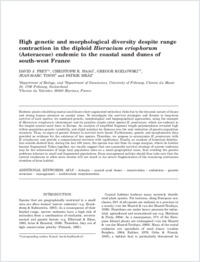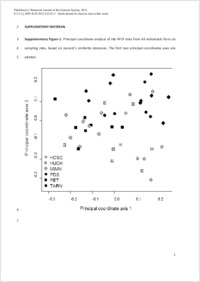High genetic and morphological diversity despite range contraction in the diploid Hieracium eriophorum (Asteraceae) endemic to the coastal sand dunes of south-west France
- Frey, David J. Department of Biology, University of Fribourg, Switzerland
- Haag, Christoph R. Department of Biology, University of Fribourg, Switzerland
- Kozlowski, Gregor Department of Biology, University of Fribourg, Switzerland - Department of Geosciences, University of Fribourg, Switzerland
- Tison, Jean-Marc Chemin du Valentier, 38540 Heyrieux, France
- Mráz, Patrik Department of Biology, University of Fribourg, Switzerland
-
04.03.2012
Published in:
- Botanical Journal of the Linnean Society. - 2012, vol. 169, no. 2, p. 365-377
AFLP
Atlantic
coastal sand dunes
conservation
endemism
genetic structure
management
multivariate morphometrics
English
Endemic plants inhabiting coastal sand dunes show augmented extinction risks due to the dynamic nature of dunes and strong human pressure on coastal areas. To investigate the survival strategies and threats to long-term survival of such species, we combined genetic, morphological and biogeographical approaches, using the example of Hieracium eriophorum (Asteraceae) and its putative cryptic sister species H. prostratum, which are endemic to the longest coastal sand dune in Europe. An analysis of amplified fragment length polymorphism revealed high within-population genetic variability, and slight isolation by distance was the only indication of genetic population structure. Thus, no signs of genetic threats to survival were found. Furthermore, genetic and morphometric data provided no evidence for the existence of two species. Therefore, we propose to synonymize H. prostratum with H. eriophorum and provide a nomenclatural overview with typification. Finally, an analysis of historical distribution records showed that, during the last 100 years, the species was lost from its range margins, where its habitat became fragmented. Taken together, our results suggest that one successful survival strategy of narrow endemics may be the achievement of large local population sizes on a small geographical scale, thus avoiding the genetic problems inherent to small and fragmented populations. Dune management policies should thus take care that the current tendencies to allow more erosion will not result in too severe fragmentation of the remaining continuous stretches of dune habitat.
- Faculty
- Faculté des sciences et de médecine
- Department
- Département de Biologie
- Language
-
- English
- Classification
- Botany
- License
- License undefined
- Identifiers
-
- RERO DOC 29058
- DOI 10.1111/j.1095-8339.2012.01215.x
- Persistent URL
- https://folia.unifr.ch/unifr/documents/302268
Other files
Statistics
Document views: 137
File downloads:
- fre_hgm.pdf: 118
- fre_hgm_sm.pdf: 81

